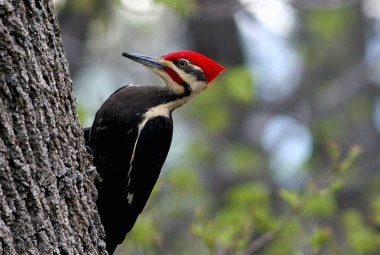
Many people have a love/hate relationship with woodpeckers, they enjoy watching and hearing their work, but do not want them choosing their home to peck at and damage. Across the world there are about 215 species of woodpeckers living, basically wherever there are wooded areas, woodpeckers can be found. Depending on the season there are about seven species of woodpeckers living in Missouri.
| Pest Identification | |
|---|---|
| Recognition | Woodpeckers are medium sized birds and most commonly identified by their feathers. The appearance of a woodpecker can vary by species, but in general their feathers are contrasting brown, yellow, and white in color, sometimes having stripe or spot markings. Along with the red “cap” of feathers found on the top of their head and down the back of their neck. Their bill is straight and pointed, their neck is strongly muscled, and they have a strong tail and feet that help them attach tightly to a tree. |
| Biology | Woodpeckers are most known for the “drumming” sound they created as they peck at trees and other wooden objects. Woodpeckers peck into trees, preferring dead trees, in order to find food (insects living in the tree) and create nesting areas. They also instinctively make drumming noise on the wood in order to establish their territory and attract a mate. Most species of woodpeckers are monogamous and the female and male work together to find a suitable nesting site, make the nest, incubate the eggs, and raise their brood. Breeding season usually runs from March through May. Females will lay 2-5 eggs; the eggs will be incubated for 11-14 days, and after hatching the young will be able to leave the nest in approximately 18-30 days. |
| Habits | Woodpeckers live in mature forests, with standing dead trees. As urban and rural areas have encroached into the woodpecker’s territory, they have become a major nuisance pest on homes and other buildings like garages and sheds. Most people that have issues with woodpeckers live in or within half a mile of a wooded area. Some woodpecker species migrate south towards warmer weather, while others stay in the area year-round despite the weather. |
| Prevention | Preventing woodpeckers or any pest bird from choosing your property to nest on can be a difficult task. Woodpeckers are often drawn to large homes that have natural wood siding, especially cedar siding. In addition to getting professional assistance, the best way to prevent problems with woodpeckers is to remove and replace any wood from the exterior of your home that is cracked or has holes in it, woodpeckers are drawn to wood that has small openings in it that can act as a starting point for their pecking. |
| Professional | The best way to prevent and control current problems with woodpeckers is to partner with a professional pest control company who has the experience and equipment to eliminate woodpeckers from your property. At Rottler, our bird control program can offer you services through our trained professionals to prevent and control woodpeckers. Our professionals will inspect your property and provide you with the best options available to remove pest woodpeckers from it. For more information about how Rottler Pest and Lawn Solutions can quickly eliminate woodpeckers from your home, contact us today. |

